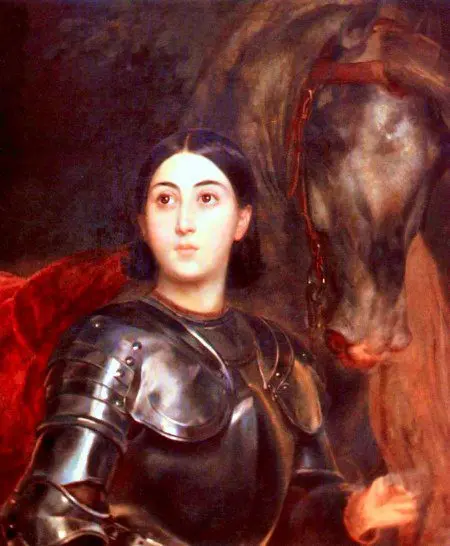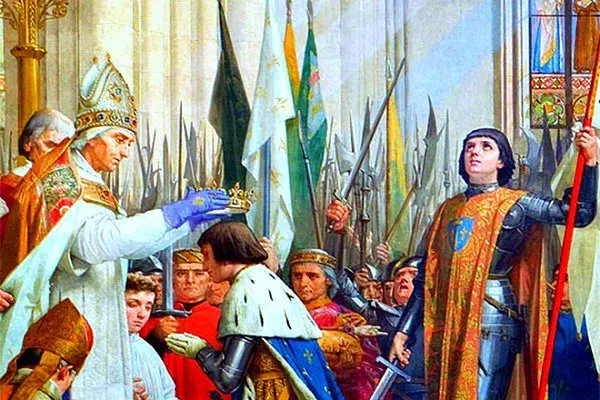Contents
😉 Greetings, history lovers! The article “Jeanne d’Arc: biography, interesting facts” is dedicated to the national heroine of France, one of the commanders of the French troops in the Hundred Years War.
Who is Joan of Arc
The heroine of France – Joan of Arc is also known as the Maid of Orleans. May 30 is celebrated in the country as a national holiday. Jeanne was a peasant. This girl inspired the army of her people during the Hundred Years War (1337-1453) to fight the British in Orleans in 1429.

Karl Pavlovich Bryullov. “Portrait of Juliet Tittoni as Joan of Arc”. 1850-1852.
This battle brought the long-awaited victory to the French. Jeanne was later captured by the British and burned at the stake for heresy (violation of religious law). She was not yet 20 years old. In 1920, centuries after her death, the Roman Catholic Church canonized Joan.
For almost 600 years, her feat has inspired writers, artists and composers to create many heroic works. In our time, Joan of Arc remains one of the most popular Catholic saints.
Wars and controversies
Jeanne was born in 1412 in a small village called Domrémy, on the border of eastern France. At that time, there was a long series of disputes between the French and the British over the French crown. Fighting has continued from time to time since 1337 and is now known as the Hundred Years War.
When young Jeanne was growing up, the situation was complicated by internal problems in France itself. King Charles VI of the Valois dynasty was often physically unable to govern the state. He suffered from regular bouts of insanity. Subsequently, Karl received the nickname Mad, although he was officially called the Beloved.
The king’s brother, the Duke of Orleans, and his cousin, the Duke of Burgundy, quarreled. They could not decide who should rule instead of King Charles’ youngest son, the Dauphin (French title of the heir to the throne).
British invasion of France
In 1415, King Henry V of Britain took advantage of the chaos in France. He invaded this country and won a convincing victory over the French army at Agincourt. Burgundy entered into an alliance with the British, and together they conquered almost all of northern France.
In 1420, the wife of Charles VI, Isabella of Bavaria, signed a treaty (agreement) in which Henry V was declared heir to the French throne. By doing so, he disinherited her own son, the Dauphin. It is worth noting that Isabella from 1403 herself managed all the affairs of the state.
Charles VI and Henry V passed away in 1422. The Dauphin tried to defend his right to the French throne and be crowned Charles VII. But Reims, where the French monarchs were traditionally crowned, ended up in the hands of the Burgundians and the British. The Dauphin was forced to move his court south to Chinon.
Visions
The village where Jeanne grew up remained loyal to Karl, despite the fact that it stood on Burgundian territory. Around 1424, Joan began to have regular visions. She identified her visions as St. Michael, St. Catherine and St. Margaret. These saints told her to go to the Dauphin.

Guided by their voices, the girl went to Vaucouleurs, the nearest city that was loyal to the Dauphin. There she asked the captain of the garrison to take her to Karl. She managed to convince him to allow a dangerous journey through enemy territory to the Dauphin’s court in Chinon.
The brave girl put on men’s clothes and set off. After 11 days, she reached the royal court. According to legend, Jeanne was allowed to meet with the Dauphin. But he decided to check her and hid among his courtiers.
Guided by the voices (visions) that visited her, the girl went straight to him. She said she wanted to go into battle against the British and see him crowned at Reims.
Siege of Orleans
After several weeks of talking, Karl allowed Joan to lead the campaign to liberate Orleans, which was under siege by British forces. She became a symbol of the French army – the presence of a young girl inspired the soldiers.
The French army went on the attack, and the British, who had surrounded Orleans, began to retreat. The girl in the battle was wounded by an arrow, but did not leave the battlefield to cheer the soldiers. The siege of Orleans fell on May 8, 1429.
Coronation of Charles VII
Jeanne persistently persuaded Karl to go to Reims, which is still deep in the enemy’s rear. The ceremony of his official coronation was to take place there. Along the way, the Dauphin’s troops fought the British before the decisive battle of Poitiers on June 18, when the British were defeated.

Coronation of Charles VII July 17, 1429, Reims Cathedral, Reims, France
Despite delays and hesitation on the part of the Dauphin, the royal army entered Reims on July 16, 1429. Charles was crowned the next day.
Despite these victories, Charles VII was unable to control the entire territory of France. Most of it was still in the hands of the British and the Duke of Burgundy. Jeanne urged the king to take the city of Paris, but Charles ordered a retreat to the Loire Valley. There he dismissed his army for the winter.
Why Joan of Arc was burned
In the spring of 1430, the troops of the Duke of Burgundy again began to attack the cities previously captured by Charles. Jeanne took several soldiers with her to one of these cities, Compiegne, to help the townspeople.
Here she fell from her horse during a retreat and was unable to get back into the saddle. The girl was captured and taken to the Duke of Burgundy, who ordered her to be imprisoned.
The captive repeatedly tried to escape from the castle of the Duke of Burgundy. In the end, she managed to jump from a high tower and land on the soft ground of the moat below. But here she was caught and sold to the British.
The British put her on trial as a heretic. (A heretic is a person whose beliefs did not correspond to the generally accepted religious beliefs of the time.) They were suspicious of her visions and her statement to speak directly to God through the voices she heard.
By accusing Joan of heresy, the British hoped to undermine Charles VII’s claim to the French throne.
The execution of Joan of Arc

Jeanne’s trial took place in Rouen, where the chief inquisitor was Bishop Beauvais, a supporter of the British. The prisoner was held in terrible conditions. She was constantly threatened and interrogated endlessly, demanding a complete renunciation of her delusions. “
A few days later she was sentenced to death. On May 30, 1431, she was burned at the stake as a heretic. The ashes were scattered over the Seine. She was 19 years old!
20 years later, Charles VII ordered an investigation into the case of Jeanne. In 1456, an ecclesiastical court ruled that she had been convicted unlawfully and declared her innocent.
Video
More information on “Joan of Arc: Biography”
If the article “Jeanne d’Arc: biography, interesting facts” was useful to you, share it on social networks! 😉 Thank you! Check out this site for new stories! There are a lot of them ahead!









